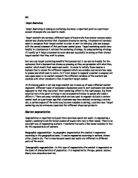Problems of segmentation
-
Individual products can be easily picked off by competitors:
-
Range proliferation:
-
Highly segmented niche products may not be as profitable as expected:
Markets for the Sony PS3 are segmented into three boards, these are summarized below:
Geographic: Geographic segmentation tries to divide markets into different geographical units. These units include the following:
• Regions: the Sony PS3is segmented into region. E.g. U.K this involves England, Scotland and Northern Ireland.
• Countries: these are categorized by size, development or membership of geographic region. E.g. France, USA.
• City / Town size: the Sony PS3 is also segmented based on population which ranges above a certain level. E.g. London, Manchester.
• Population density: segmentation under this can be done in the following urban, suburban, rural, semi-rural.
• Climate: e.g. Northern, Southern
Geographic segmentation is an important process - particularly for multi-national and global businesses and brands. Many such companies have regional and national marketing programmes which alter their products, advertising and promotion to meet the individual needs of geographic units.
Demographic: consists of dividing the market into groups based on variables such as age, gender family size, income, occupation, education, religion, race and nationality. As you might expect, demographic segmentation variables are amongst the most popular bases for segmenting customer groups. This is partly because customer wants are closely linked to variables such as income and age. Also, for practical reasons, there is often much more data available to help with the demographic segmentation process. The main demographic segmentation variables are summarized below:
- AGE: Consumer needs and wants change with age although they may still wish to consumer the same types of product. E.g. Sony design, package and promote products differently to meet the wants of different age groups.
- Life-cycle stage: A consumer stage in the life-cycle is an important variable - particularly in markets such as electronics and technology.
- Gender: Gender segmentation is widely used in consumer marketing. The best example include Sony ps3 games for boys, girls.
- Income: Another popular basis for segmentation. Sony PS3 Company target affluent consumers with luxury accessories and convenience services. Good examples include customized accessories.
-
Social class: Sony PS3 believes that a consumer "perceived" social class influences their preferences for its products and accessories. There is a clear link here with income-based segmentation.
- Lifestyle: Sony PS3 is increasingly interested in the effect of consumer "lifestyles" on demand. Unfortunately, there are many different lifestyle categorization systems, many of them designed by its advertising and marketing departments as a way of winning new marketing clients and campaigns.
Psychographic Segmentation: Behavioral segmentation divides customers into groups based on the way they respond to, use or know of a product. Behavioral segments can group consumers in terms of:
- Occasions: When a product is consumed or purchased. For example, ps3 have traditionally been marketed as a seventh generation video game.
- Usage: Some markets can be segmented into light, medium and heavy user groups. E.g. the Sony PS3 comes in form of different memory sizes which is due to its usage process.
-
Loyalty: Loyal consumers - those who buy one brand all or most of the time - are valuable customers. Sony PS3 company try to segment their products into those where loyal customers can be found and retained compared with segments where customers rarely display any product loyalty.
-
Benefits Sought: An important form of behavioral segmentation. Benefit segmentation requires Marketers to understand and find the main benefits customers look for in a product. An excellent example is the Gaming market where research has found four main "benefit segments" - economic; medicinal, cosmetic and taste.
Target market: this is the specific individuals, market segment, or customer group that is the focus or objective of an advertisers promotion plan and campaign efforts.
Target Market for Sony PS3 and why:
- Teenagers;
- School going children
- Lovers the following sorts of games:
Action, Adventure, Sports, simulation.
- Adults (especially 18+ game lovers)
the above are the target market for the Sony PS3, because they are the ones who have much interest in the product than others and they are mainly the buyers too.
Reasons for Segmenting in this way:
Due to large number of users involved; the number of users involved in using the Sony PS3 is very large, so by doing it in this way the company would be able to meet its targets and aims.
To retain more customers; segmenting the Sony PS3 in this way will help them retain more customers. Retaining more customers will help them retain more profits.
To increase products distributed or sold; segmenting the product in many areas, will force the number of units distributed increase rapidly because of the number of people involved.
To retain more profit; this type of segments will cause the profit of the company to increase because of the number of units involved and the number of new customers also involved in the activity.
To increase its market share; the segmenting of the Sony PS3 in this way will force it the market share of the company to improve/increase.







